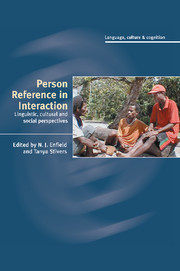Book contents
- Frontmatter
- Contents
- List of contributors
- Preface
- Acknowledgements
- 1 Person reference in interaction
- Part I Person reference as a system
- Part II The person reference system in operation
- Part III The person reference as a system in trouble
- 11 Intersubjectivity and progressivity in person (and place) reference
- 12 Repairing person reference in a small Caribbean community
- 13 Reference and ‘référence dangereuse’ to persons in Kilivila: an overview and a case study
- References
- Index
12 - Repairing person reference in a small Caribbean community
Published online by Cambridge University Press: 22 September 2009
- Frontmatter
- Contents
- List of contributors
- Preface
- Acknowledgements
- 1 Person reference in interaction
- Part I Person reference as a system
- Part II The person reference system in operation
- Part III The person reference as a system in trouble
- 11 Intersubjectivity and progressivity in person (and place) reference
- 12 Repairing person reference in a small Caribbean community
- 13 Reference and ‘référence dangereuse’ to persons in Kilivila: an overview and a case study
- References
- Index
Summary
Introduction: trouble and repair in person reference
There are various kinds of trouble that may beset practices for referring to persons in conversation. The reference can fail because it was not heard, or because the form used has more than one possible referent. Alternatively, it may fail because the form used is unfamiliar to the recipient. It seems reasonable to suppose that these problems will not arise with the same frequency in every community. In a community that uses bare names to achieve recognitional reference but has only a few of these shared between many individuals, problems are likely to arise due to the failure of a given name to provide for unique reference. In a community where people are known by many different names, problems may more frequently result from the fact that the name used is not the one by which the recipient knows the person to whom reference is being made. In this chapter, I examine troubles encountered in the course of making recognitional reference to persons in a small Caribbean community. An analysis of the various practices involved in the repair and resolution of such problems leads to two conclusions:
Repairs are intricately recipient-designed with subsequent recognitional forms selected to solve particular, context-specific, interactional problems.
Although person reference and other initiated repair are essentially generic organizations of talk-in-interaction, they are nevertheless adapted to particular local circumstances (such as the local onomastic system) and are thus locally inflected.
- Type
- Chapter
- Information
- Person Reference in InteractionLinguistic, Cultural and Social Perspectives, pp. 281 - 308Publisher: Cambridge University PressPrint publication year: 2007
- 11
- Cited by



